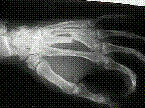- Discussion:
- usually result from direct blow;
- presents w/ dorsal angulation & increased palmar displacement of metacarpal heads because of deforming force of interosseous muscles and long flexor muscles, which are volar to the fracture plane;
- more proximal frxs (ie, shaft frx) are more likely to produce noticable dorsal angulation & clawing, and therefore less angulation can be accepted in midshaft fractures than in neck frx;
- Clinical Effects: (of dorsal angulation);
- weakened grip;
- hyperextension at MP joint;
- reduced extension at the PIP joint;
- Closed Reduction:
- easy to reduce by difficult to maintain;
- MCP & PIP joints are both flexed 90 deg to gain control of distal fragment & then exert dorsally directed force on metacarpal to push metacarpal head dorsally (& metacarpal shaft volarly) to achieve reduction;
- immobilization in this position is not allowed, however, as flexion contracture will develop;
- more proximal frxs (ie, shaft frx) are more likely to produce noticable dorsal angulation & clawing, and therefore less angulation can be accepted in midshaft fractures than in neck frx;
- Acceptable Reduction:
- index and long metacarpals:
- minimal angulation can be accepted because there is no compensatory motion at the CMC joints;
- do not tolerate > 10 deg;
- ring & little metacarpals:
- little finger CMC articulation allows flexion extension arc of 20-30 deg;
- slight rotatory arc motion assists little finger in contacting thumb;
- ring metacarpal has 10-15 deg of mobility;
- will tolerate some dorsal angulation < 20 deg;
- more angulation is accepted for more distal fractures;


